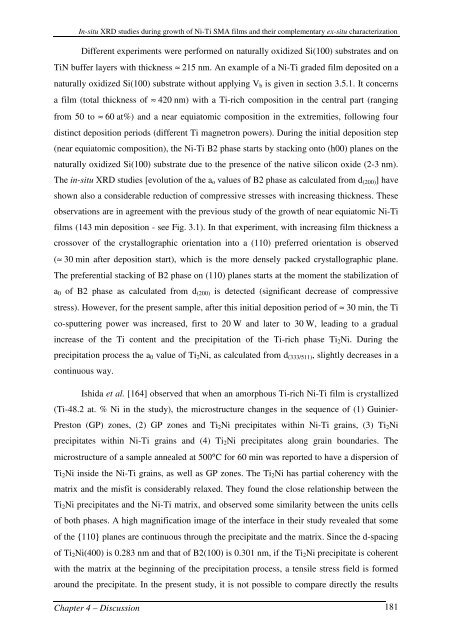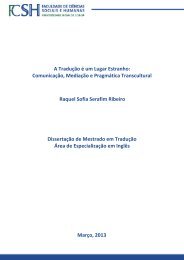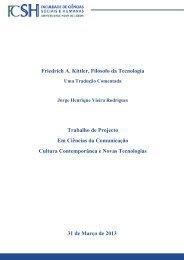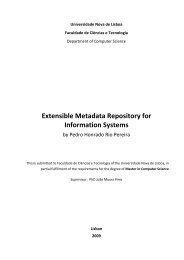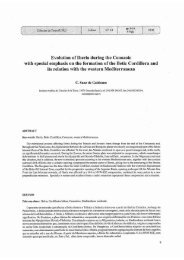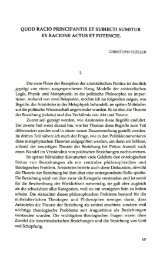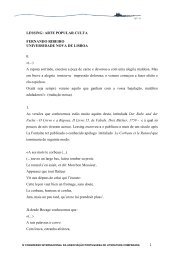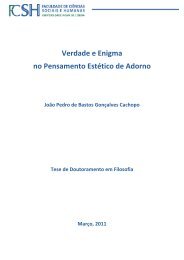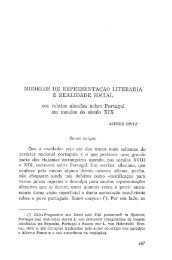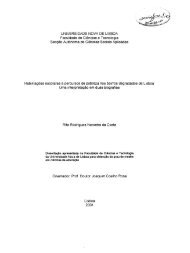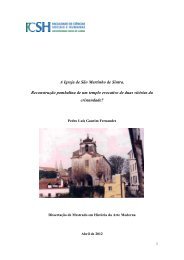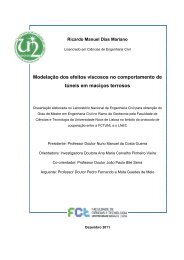PhD Thesis_RuiMSMartins.pdf - RUN UNL
PhD Thesis_RuiMSMartins.pdf - RUN UNL
PhD Thesis_RuiMSMartins.pdf - RUN UNL
Create successful ePaper yourself
Turn your PDF publications into a flip-book with our unique Google optimized e-Paper software.
In-situ XRD studies during growth of Ni-Ti SMA films and their complementary ex-situ characterization<br />
Different experiments were performed on naturally oxidized Si(100) substrates and on<br />
TiN buffer layers with thickness ≈ 215 nm. An example of a Ni-Ti graded film deposited on a<br />
naturally oxidized Si(100) substrate without applying V b is given in section 3.5.1. It concerns<br />
a film (total thickness of ≈ 420 nm) with a Ti-rich composition in the central part (ranging<br />
from 50 to ≈ 60 at%) and a near equiatomic composition in the extremities, following four<br />
distinct deposition periods (different Ti magnetron powers). During the initial deposition step<br />
(near equiatomic composition), the Ni-Ti B2 phase starts by stacking onto (h00) planes on the<br />
naturally oxidized Si(100) substrate due to the presence of the native silicon oxide (2-3 nm).<br />
The in-situ XRD studies [evolution of the a o values of B2 phase as calculated from d (200) ] have<br />
shown also a considerable reduction of compressive stresses with increasing thickness. These<br />
observations are in agreement with the previous study of the growth of near equiatomic Ni-Ti<br />
films (143 min deposition - see Fig. 3.1). In that experiment, with increasing film thickness a<br />
crossover of the crystallographic orientation into a (110) preferred orientation is observed<br />
(≈ 30 min after deposition start), which is the more densely packed crystallographic plane.<br />
The preferential stacking of B2 phase on (110) planes starts at the moment the stabilization of<br />
a 0 of B2 phase as calculated from d (200) is detected (significant decrease of compressive<br />
stress). However, for the present sample, after this initial deposition period of ≈ 30 min, the Ti<br />
co-sputtering power was increased, first to 20 W and later to 30 W, leading to a gradual<br />
increase of the Ti content and the precipitation of the Ti-rich phase Ti 2 Ni. During the<br />
precipitation process the a 0 value of Ti 2 Ni, as calculated from d (333/511) , slightly decreases in a<br />
continuous way.<br />
Ishida et al. [164] observed that when an amorphous Ti-rich Ni-Ti film is crystallized<br />
(Ti-48.2 at. % Ni in the study), the microstructure changes in the sequence of (1) Guinier-<br />
Preston (GP) zones, (2) GP zones and Ti 2 Ni precipitates within Ni-Ti grains, (3) Ti 2 Ni<br />
precipitates within Ni-Ti grains and (4) Ti 2 Ni precipitates along grain boundaries. The<br />
microstructure of a sample annealed at 500°C for 60 min was reported to have a dispersion of<br />
Ti 2 Ni inside the Ni-Ti grains, as well as GP zones. The Ti 2 Ni has partial coherency with the<br />
matrix and the misfit is considerably relaxed. They found the close relationship between the<br />
Ti 2 Ni precipitates and the Ni-Ti matrix, and observed some similarity between the units cells<br />
of both phases. A high magnification image of the interface in their study revealed that some<br />
of the {110} planes are continuous through the precipitate and the matrix. Since the d-spacing<br />
of Ti 2 Ni(400) is 0.283 nm and that of B2(100) is 0.301 nm, if the Ti 2 Ni precipitate is coherent<br />
with the matrix at the beginning of the precipitation process, a tensile stress field is formed<br />
around the precipitate. In the present study, it is not possible to compare directly the results<br />
Chapter 4 – Discussion 181


